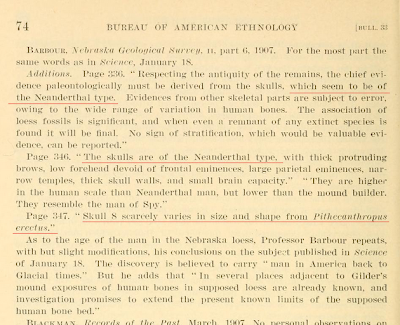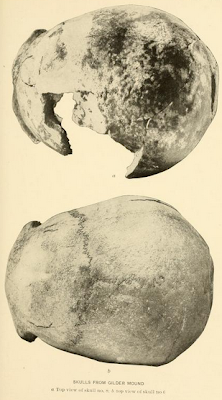Some surprisingly "Neanderthal-like" skulls found in Nebraska early last century which show a rather "sturdy" build, with prominent supraorbital arches and slanting forehead, were, as could be expected, dismissed by Aleš Hrdlička in his book on "early man in North America" he considered this "Nebraska Loess Man" as recent. The story, and a link to his book is below:
By the way, Loess is a silt-sized sediment, which is formed by the accumulation of wind-blown dust, and as such is found in all of the World's great plains.
Finding the remains
The original finding dates to 1894, when a group of men (Parker, Morris and Huntington) were searching for the remains of Indian Chief Black Hawk.
They dug a pit on the crest of a wooded hillock 10 miles north of Omaha, Nebraska, and discovered an odd skull about 1.2 m below ground level (4 ft.).
The remains were packed and left untouched until 1906, when they heard about another similar discovery by Mr. Gilder and sent the skull via Gilder to the University of Nebraska.
An expedition was organized that summer and new digs produced more bones, skulls and even "two flint blades of ordinary form".
Science magazine's issue of Nov. 16, 1906 reported the findings: antique remains of the "Nebraska loess man".
Below are some of Gilder's remarks in the media. I underlined the interesting parts in red.
Below are two of the skulls found at the site:
Hrdlicka's comments
Enter Ales Hrdlicka (1860-1943). He migrated to the US, as a medical student from Bohemia. The state of New York employed him as an associate in anthropology and pathology. He went to Paris in 1896 studying with Leonce Manouvrier in Broca's laboratory. He was later hired (1903) as an anthropologist by the United States National Museum. In 1918 he established the American Journal of Physical Anthropology. He also was a forceful figure who emphatically argued that native American Indian populations had come to America across the Bering Straits from Asia in recent times. He never found any evidence of Paleolithic peoples in the New World.
Loess Man would not be an exception, he demolished its antiquity in his book.
He wrote that if it were not for their pronounced brow ridges, they would have been dismissed as recent burials.
He gives the following reasons for discarding their antiquity:
Their shallow depth (2.5 - 5 ft. ; 0.7 to 1.5 m). The fire hardened soil (a common practice among the local natives to protect burials) he brushes aside the fact that many skeletons were fragmented and their parts dispersed within the mound, which would be unexpected in a controlled burial. The fact that they had not fossilized. Some bones had "rodent bites" so he surmises that mice ate the bones and dragged them into their burrows deep in the mound, which later collapsed making the bones appear at deeper levels than they originally had.
Last but not least he says that sloping foreheads and pronounced brow ridges are common among contemporary natives and also mentions other mounds which held similar Neandertal-like skulls (see page 92). I wonder if they were not actually ancient burials!.
Read the full text below as from page 66 by following the link below.
PS.. A comment on the "flint" tools:
Not far from these bits of bone, and in apparently undisturbed loess soil I found a small chip of whitish pink flint, very sharp and no larger than a gold dollar. This, to me, is an important find and carries more weight, as evidence, than anything else I have seen from that field. If this specimen of flint was used by the loess man, this same loess man must have visited the home of this flint or he must have trafficked with those who did visit the original quarry. If I mistake not this flint is the same as that brought north by the Pawnees about 1400 A. D. A number of bits of gray flint were found in the excavation which are certainly from the Nehawka quarry. This proves little, as the Nehawka quarry is not far away and primitive man used flint; the nodules crop out at Nehawka and this loess man may have found his flint on the surface. Perfect implements will be found in some future excavation, and when they are found much may be learned from them.
The above is from page 338 of NEBRASKA STATE HISTORICAL SOCIETY, (1907).
Also read Poynter's bigoted 1915 study on Nebraska Man's remains(Stating that the low browed remains "may be considered as belonging to a low order racially")
Sources
[1] Aleš Hrdlička,(1907).Skeletal remains suggesting or attributed to early man in North America. Published 1907 by Govt. print. off. in Washington. Edition Notes: Series Smithsonian institution. Bureau of American ethnology. Bulletin 33.
Patagonian Monsters - Cryptozoology, Myths & legends in Patagonia Copyright 2009-2014 by Austin Whittall ©



















I wonder where those skulls ended? In a trash container?
ReplyDelete